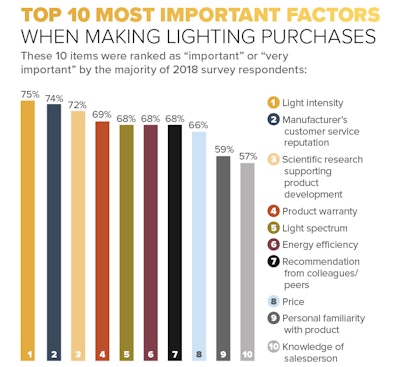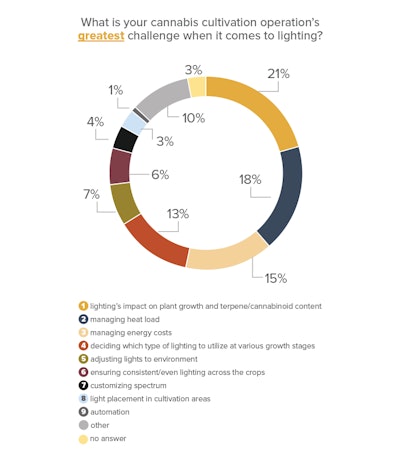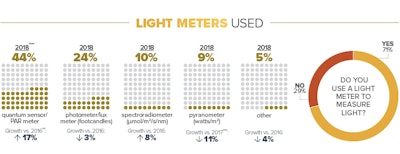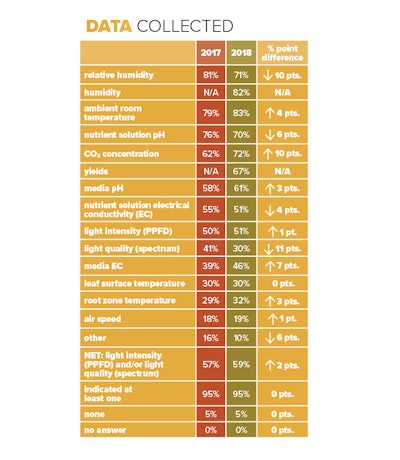Participating cultivators cited various challenges as their top concerns when it comes to lighting, including: managing heat loads (18% of respondents cited this as their greatest lighting challenge), managing energy costs (15%), choosing the right lighting type for each growth stage (13%), adjusting lights to the environment (7%), and ensuring consistent lighting across crops (6%).
The most common challenge cultivators face in lighting, however, has nothing to do with how fixtures interact with the environment: Over a fifth of cultivators (21%) said their greatest lighting challenge was figuring out lighting’s exact impact on plant growth and terpene/cannabinoid content.

So Where Do Cultivators Find Lighting Information?
As markets mature, cannabis cultivators are turning to trusted information sources to help them address those challenges. Industry publications are the only consensus pick in trusted sources of lighting information, with more than half of study participants (57%) ranking trade magazines in their Top 3 information sources. Just under half (48%) rank colleagues/industry peers in their Top 3 sources of lighting information, while industry researchers and studies are among the Top 3 for 42% of growers.
The availability of resources outside of industry peers and dedicated cannabis blogs (which 21% of growers said was among their Top 3 information sources) is a fairly new reality. Until recently, scientific research and academic studies on cannabis horticulture were few and far between. Today, international cannabis markets such as Canada and Israel are forging the path for university-sponsored research, and state-sanctioned partnerships between U.S. cannabis companies and universities, like those seen in Pennsylvania, are starting to flourish—all of which will offer more information and insight into the complexities of cannabis cultivation.

Why Buy?
Scientific information that is currently available on lighting is highly regarded by cultivators. As was mentioned in the introduction of this report, 72% of survey respondents say the availability of scientific research supporting product development is an “important” or “very important” factor in their decision to buy lighting fixtures, but it is not the most important factor. Both light intensity and the vendor’s customer service reputation were cited by more cultivators as “important” or “very important” (75% and 74%, respectively).
Rounding out the Top 10 most important factors in lighting purchases are: product warranty (69%), light spectrum (68%), energy efficiency (68%), recommendation from colleague/peers (68%), price (66%), personal familiarity with product (59%), and knowledge of salesperson (57%).

Making Data-Informed Decisions
Cultivators aren’t waiting for university researchers to tell them what the optimal conditions for cannabis cultivation are; many are performing their own data tracking. Nearly all (95%) of study participants in both 2017 and 2018 tracked at least one data point about their operations. General humidity and ambient room temperature are the most commonly tracked data points—both are tracked by more than 80% of 2018 survey participants.

CO2 (carbon dioxide) is becoming a bigger point of interest for cultivators. In 2017, 62% of cultivators said they tracked CO2 concentration in their grow environments. That number increased by 10 percentage points in 2018 to 72% of growers.
The portion of cultivators who track light intensity (photosynthetic photon flux density—PPFD) and/or light quality (spectrum) also increased, albeit slightly, between 2017 and 2018, from 57% to 59%, as did the portion of those who track growing media electrical conductivity (EC) (39% to 46%) and growing media pH (58% to 61%). Fewer growers tracked nutrient solution pH in 2018 than 2017 (dropping from 76% in 2017 to 70% in 2018) and nutrient solution EC (55% to 51%).
















